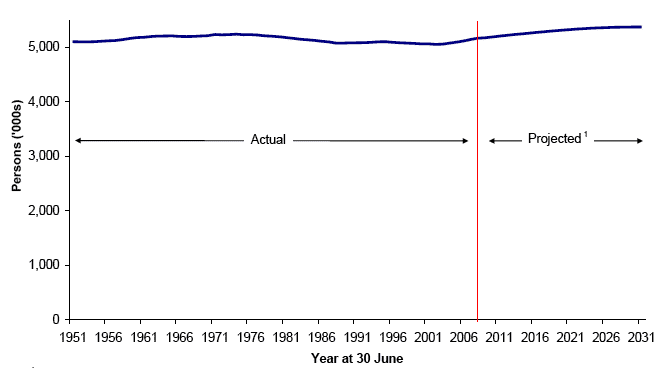
The latest estimate of Scotland’s population (on 30 June 2008) is 5,168,500 – the highest since 1981 and an increase of 24,300 people on the previous year. There are almost 114,000 more people in Scotland than in 2002, when the population hit its lowest level since just after the Second World War.
The recent increase in Scotland’s population has been driven mostly by net in-migration although, recently, there have also been more births than deaths. In the twelve months to 30 June 2008, in-migration exceeded out-migration by 20,000. This included a net gain of around 11,500 from the rest of the UK and a net gain of around 7,700 from overseas (including asylum seekers). Movements to and from the armed forces showed a net gain of around 800. In the same period, there were around 3,900 more births than deaths (59,240 births and 55,290 deaths), the number of births having risen by more than 2,500 and the number of deaths having fallen by almost 400 compared to the year to end June 2007.
The rise in Scotland’s population in the last six years should be seen in the context of the relative stability of the population over the last 50 years, as shown in Figure 1.1. The population reached a peak of 5.24 million in 1974 before falling to 5.05 million in 2002 and then rising again in the last six years.
Figure 1.1 Estimated population of Scotland, actual and projected, 1951-2031

1 2006-based projections.
Figure 1.2 shows the trends in natural change (births minus deaths) and migration. Between 1966 and 1974, both natural change and net out-migration fell dramatically, although the natural increase generally remained greater than net out-migration. This resulted in a growth in population up to 1974. From that point on, through the late 1970s and the 1980s, net out-migration was higher than the natural increase, causing the population to decline. In recent years the gap between births and deaths has closed, and for some years reversed, and Scotland has experienced record levels of net in-migration resulting in small increases in the population over each of the last 6 years.
Figure 1.2 Natural change and net migration, 1951-2008
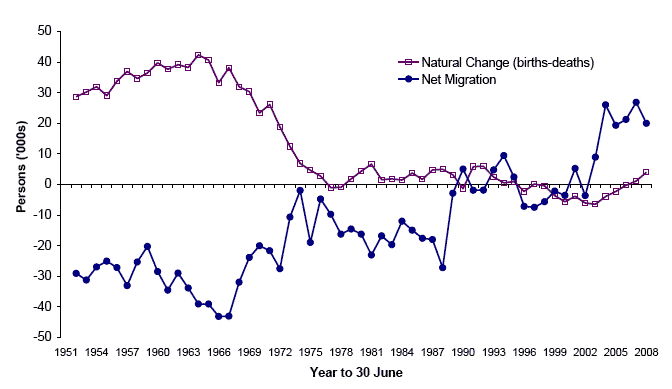
Age Structure
The age/sex composition is one of the most important aspects of the population, as changes in the number of men and women in different age groups will have different social and economic impacts. For example, increases in the elderly population are likely to place a greater demand on health and social services.
Figure 1.3 shows the age structure of the population in 2008. Eighteen per cent of the population was aged under 16 while 20 per cent was of pensionable age (60 and over for women and 65 and over for men) and the remaining 63 per cent of working age (16-59 for women, 16-64 for men). Amongst older people, particularly those aged over 75, the higher number of females reflects the longer expectation of life for women, partly as a result of male mortality rates during the Second World War. The sharp peak at age 61, and the bigger bulge between the ages of around 35 and 50, are the result of the two baby booms of 1947 and the 1960s.
Figure 1.3 Estimated population by age and sex, 30 June 2008
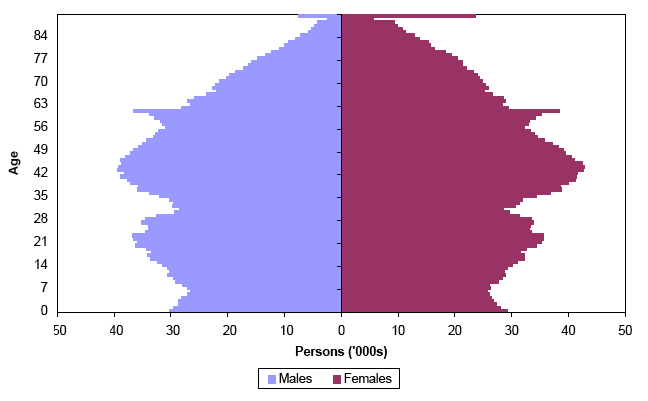
The changing structure of Scotland’s population since 1998 is illustrated in Figure 1.4. During this period the population has increased by around 91,400 (1.8 per cent), from 5.08 million to 5.17 million. Of particular note is the decrease of 9 per cent in the number of children under 16 and the increase of 13 per cent in the number of people aged 75 and over. The ageing of the population is also evident in the rise of 14 per cent in the 45-59 age group, and of 10 per cent in the 60-74 age group.
Figure 1.4 The changing age structure of Scotland’s population, 1998-2008
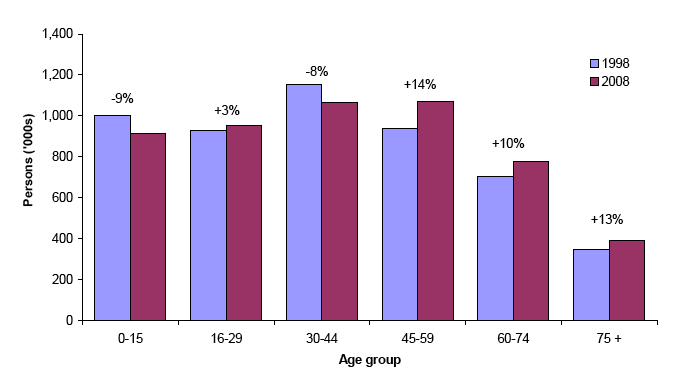
Changes within Scotland
The map at Figure 1.5 shows the percentage change in population between 1998 and 2008 for each Council area.
The Council areas in which the population fall was greatest were Inverclyde (-5.9 per cent), Eilean Siar (-4.9 per cent) and Dundee City (-4.8 per cent). The largest absolute reduction in numbers was in Dundee City (-7,210). West Lothian (+10.6 per cent), East Lothian (+8.8 per cent) and Perth & Kinross (+7.1 per cent) saw the greatest percentage increases, with the largest increase in absolute numbers in City of Edinburgh (+25,410).
Figure 1.5 Percentage population change by Council area, 1998 - 2008
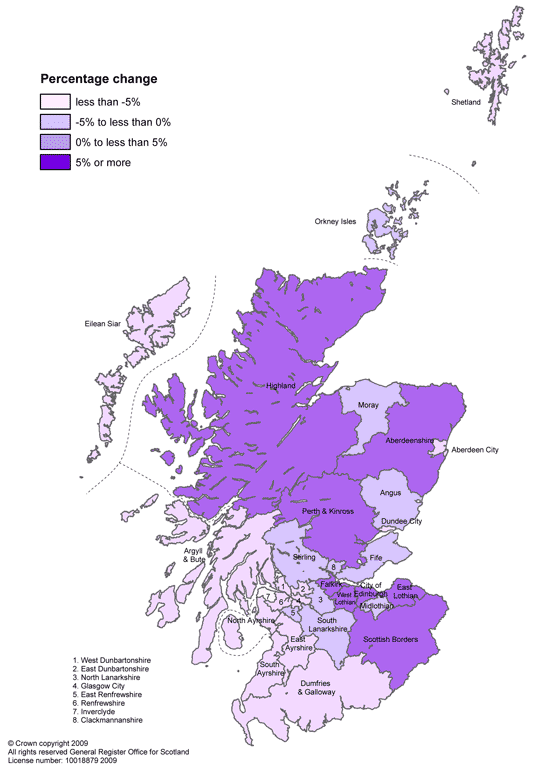
The relative importance of migration and natural change differs between areas. In some areas of population increase, such as West Lothian and Aberdeenshire, the gain is attributable both to migration and to natural increase. In other areas, the population increase is due to in-migration, despite the number of deaths exceeding the number of births. These included Perth & Kinross, Scottish Borders, Highland and Orkney Islands. Other areas with a population increase but with a near-zero natural change were East Lothian, Falkirk and Stirling.
Similarly, some areas of population decline, such as Inverclyde, Dundee City, West Dunbartonshire and Renfrewshire have experienced decreases both from migration and natural change. In contrast, the main factor in the population decline of East Dunbartonshire, Shetland Islands and Aberdeen City is net out-migration. In other areas such as Argyll & Bute and North, East and South Ayrshire the population decline was mainly attributable to more deaths than births. This analysis is shown in Table 1.1, which compares the rates of natural change and migration per 1,000 population across the local authority areas.
Table 1.1 Components of population change for Council areas: 1998-2008
Natural change 1,2 |
Net civilian migration and other changes 1,2 |
Percentage Population change 2,3 |
|
|---|---|---|---|
SCOTLAND |
-0.5 |
2.3 |
1.8 |
Council areas |
|||
Inverclyde |
-2.5 |
-3.4 |
-5.9 |
Eilean Siar |
-4.8 |
-0.1 |
-4.9 |
Dundee City |
-1.6 |
-3.2 |
-4.8 |
West Dunbartonshire |
-1.4 |
-2.8 |
-4.2 |
East Dunbartonshire |
-0.3 |
-3.7 |
-4.0 |
Shetland Islands |
1.8 |
-4.9 |
-3.2 |
Renfrewshire |
-0.8 |
-2.3 |
-3.1 |
Aberdeen City |
0.0 |
-2.4 |
-2.4 |
South Ayrshire |
-3.6 |
2.2 |
-1.5 |
Argyll & Bute |
-4.0 |
2.7 |
-1.3 |
North Ayrshire |
-1.4 |
0.3 |
-1.1 |
East Ayrshire |
-1.6 |
0.7 |
-0.9 |
Glasgow City |
-1.3 |
0.8 |
-0.5 |
Dumfries & Galloway |
-3.0 |
2.8 |
-0.1 |
Angus |
-2.1 |
2.6 |
0.5 |
Midlothian |
0.9 |
-0.3 |
0.5 |
East Renfrewshire |
0.7 |
0.4 |
1.0 |
North Lanarkshire |
1.2 |
-0.2 |
1.0 |
Moray |
-0.4 |
1.6 |
1.1 |
Orkney Islands |
-1.9 |
3.4 |
1.5 |
South Lanarkshire |
-0.2 |
2.4 |
2.2 |
Clackmannanshire |
0.4 |
3.8 |
4.3 |
Stirling |
-0.2 |
4.5 |
4.3 |
Fife |
-0.3 |
4.7 |
4.4 |
Highland |
-0.9 |
5.9 |
5.1 |
Falkirk |
0.3 |
5.1 |
5.3 |
Edinburgh, City of |
0.4 |
5.3 |
5.7 |
Scottish Borders |
-2.3 |
8.4 |
6.0 |
Aberdeenshire |
1.5 |
5.3 |
6.7 |
Perth & Kinross |
-2.0 |
9.1 |
7.1 |
East Lothian |
-0.2 |
9.0 |
8.8 |
West Lothian |
4.0 |
6.6 |
10.6 |
1 Per year per 1,000 population at 1998
2 The underlying data used to produce these figures can be found in Table 7 of the 'Mid-2008 Population Estimates Scotland' publication.
3 Ordered by population change.
Projected population
The latest population projections are based on the estimate of Scotland’s population at 30 June 2006. These projections, based on existing trends and making no allowance for the future impact of government policies and other factors, show the total population of Scotland rising from 5.12 million in 2006 to 5.37 million in 2031 (Figure 1.1). Longer term projections show the population peaking in 2031 and then slowly declining.
Until around 2021, natural change and migration both act to increase the size of the population as the number of births exceeds the number of deaths and there is net in-migration. After that point, the number of deaths exceeds the number of births whilst the net migration into Scotland continues. By 2031, the natural decrease more than cancels out the net in-migration and so Scotland’s population begins to fall - as Figure 1.6 shows.
Figure 1.6 Births and deaths, actual and projected, Scotland, 1951-2031
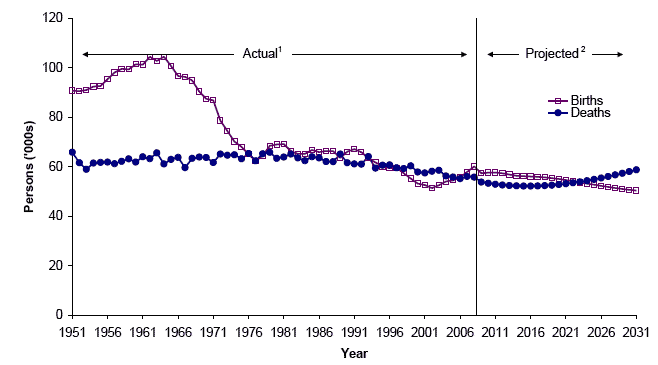
1 Calendar year.
2 2006-based mid-year projections.
Between 2006 and 2031, Scotland’s population is projected to age markedly. As shown in Figure 1.7, the number of children aged under 16 is projected to decrease by 7 per cent, from 0.92 million to 0.86 million. The number of people aged 60 and over is projected to rise by 54 per cent, from 1.12 million to 1.72 million.
Figure 1.7 The projected percentage change in age structure of Scotland’s population, 2006-20311
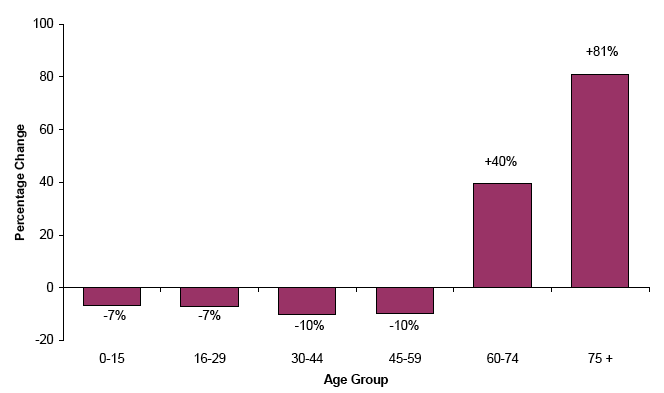
1 2006-based projections
‘Dependency ratios’ are the number of dependants - children aged under 16 and people of pensionable age - per 1,000 working age population. Figure 1.8, which takes account of the increase in the pensionable age for both men and women1, shows little overall change in these ratios over the next 15 years, but a fairly rapid increase in the pension age population relative to the working age population in subsequent years.
Figure 1.8 Dependency ratios1(per thousand working population), 2006-2031
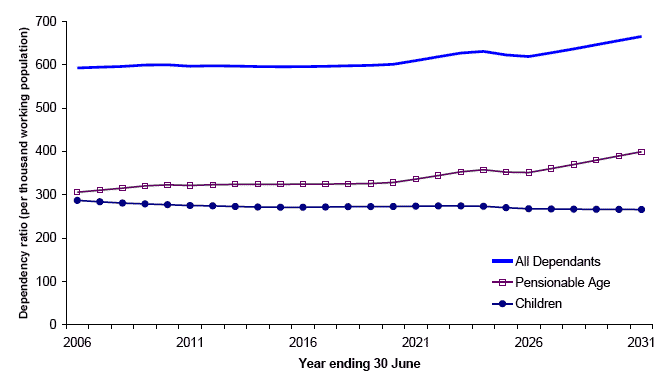
1 2006-based projections
As demographic behaviour is uncertain, a number of variant projections of the future population have been calculated, based on alternative assumptions of future fertility, mortality and migration, in addition to the ‘principal projection’ on which the previous paragraphs are based. The variant projections give users an indication of this uncertainty. They illustrate plausible alternative scenarios, rather than representing upper or lower limits of future demographic behaviour. These variant projections, and the assumptions used, can be found on the Government Actuary’s Department (GAD) website: http://www.gad.gov.uk/.
Scotland’s position within Europe
The population of most of the countries in Europe is projected to increase over the next few years. Scotland’s population is projected to rise by 5.0 per cent between 2006 and 2031. However countries such as Ireland and Spain, as well as the rest of the UK, are projected to have much bigger increases. The population of Europe (EU-27) is projected to increase by 5.5 per cent and the EU-15 by 9.1 per cent during this period. However Germany, and a number of Eastern European countries, have a projected population decline as Figure 1.9 shows.
Figure 1.9 Projected percentage population change in selected European countries 2006-2031
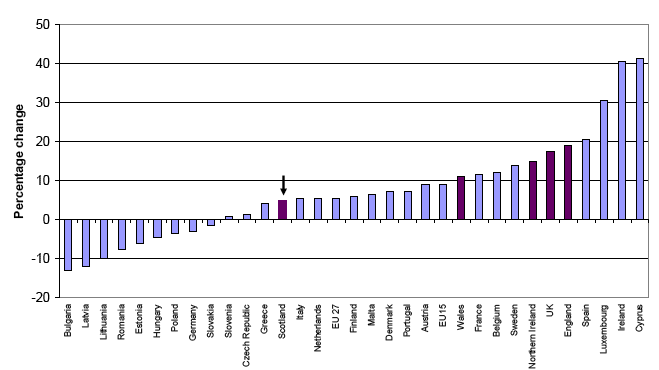
Source: ONS (UK and constituent countries) and Eurostat. Projections for the UK and its constituent countries are 2006-based whilst Eurostat projections are 2008 based. As a result Eurostat population estimates for 2006 have been used to allow comparison between 2006 and 2031 throughout. See "Appendix 2 - Notes and Definitions" for definition of EU15 and EU27.
Scotland is not alone in having an ageing population. The pattern of change over the last twenty years, and the projected change in the age distribution, is similar to that of other countries in the UK and Europe, although the rate of change varies.